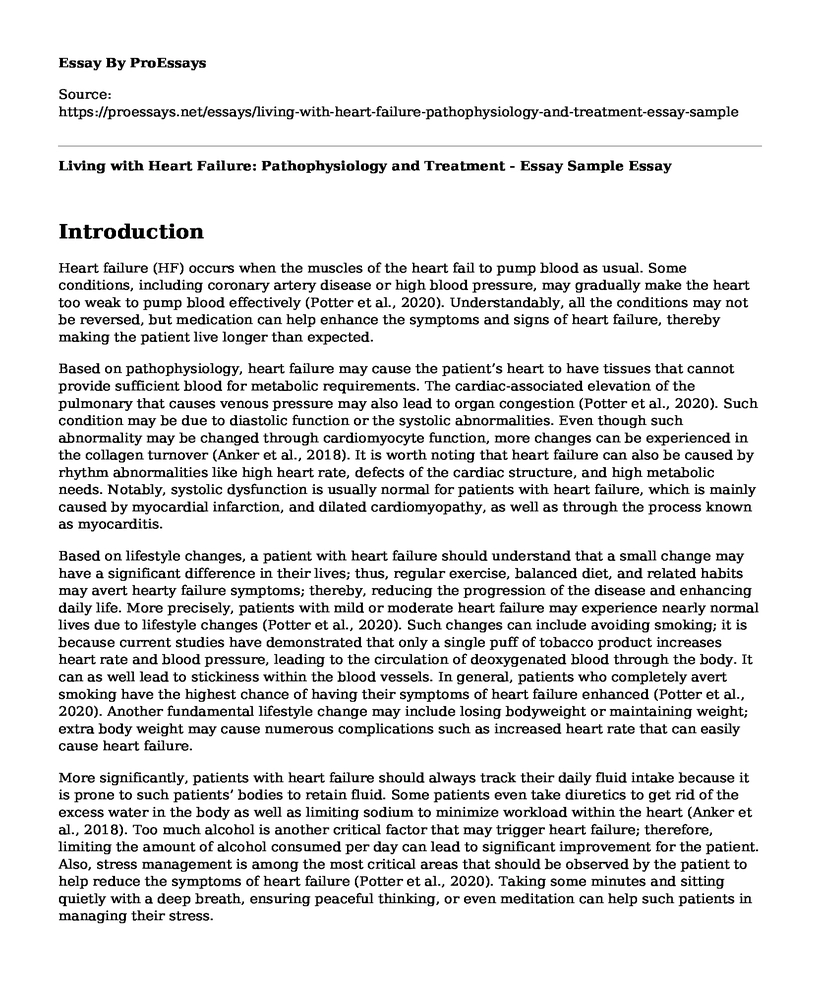Introduction
Heart failure (HF) occurs when the muscles of the heart fail to pump blood as usual. Some conditions, including coronary artery disease or high blood pressure, may gradually make the heart too weak to pump blood effectively (Potter et al., 2020). Understandably, all the conditions may not be reversed, but medication can help enhance the symptoms and signs of heart failure, thereby making the patient live longer than expected.
Based on pathophysiology, heart failure may cause the patient’s heart to have tissues that cannot provide sufficient blood for metabolic requirements. The cardiac-associated elevation of the pulmonary that causes venous pressure may also lead to organ congestion (Potter et al., 2020). Such condition may be due to diastolic function or the systolic abnormalities. Even though such abnormality may be changed through cardiomyocyte function, more changes can be experienced in the collagen turnover (Anker et al., 2018). It is worth noting that heart failure can also be caused by rhythm abnormalities like high heart rate, defects of the cardiac structure, and high metabolic needs. Notably, systolic dysfunction is usually normal for patients with heart failure, which is mainly caused by myocardial infarction, and dilated cardiomyopathy, as well as through the process known as myocarditis.
Based on lifestyle changes, a patient with heart failure should understand that a small change may have a significant difference in their lives; thus, regular exercise, balanced diet, and related habits may avert hearty failure symptoms; thereby, reducing the progression of the disease and enhancing daily life. More precisely, patients with mild or moderate heart failure may experience nearly normal lives due to lifestyle changes (Potter et al., 2020). Such changes can include avoiding smoking; it is because current studies have demonstrated that only a single puff of tobacco product increases heart rate and blood pressure, leading to the circulation of deoxygenated blood through the body. It can as well lead to stickiness within the blood vessels. In general, patients who completely avert smoking have the highest chance of having their symptoms of heart failure enhanced (Potter et al., 2020). Another fundamental lifestyle change may include losing bodyweight or maintaining weight; extra body weight may cause numerous complications such as increased heart rate that can easily cause heart failure.
More significantly, patients with heart failure should always track their daily fluid intake because it is prone to such patients’ bodies to retain fluid. Some patients even take diuretics to get rid of the excess water in the body as well as limiting sodium to minimize workload within the heart (Anker et al., 2018). Too much alcohol is another critical factor that may trigger heart failure; therefore, limiting the amount of alcohol consumed per day can lead to significant improvement for the patient. Also, stress management is among the most critical areas that should be observed by the patient to help reduce the symptoms of heart failure (Potter et al., 2020). Taking some minutes and sitting quietly with a deep breath, ensuring peaceful thinking, or even meditation can help such patients in managing their stress.
Concerning its medication, ACE inhibitors prevent the creation of angiotensin growth promoter and vasoconstrictor, promoting the concentration of the vasodilator bradykinin by hindering its degradation. The bradykinin has a beneficial impact on the production of nitric oxide, which causes the positive hemodynamic outcome of the ACE inhibitor (Potter et al., 2020). The ACE inhibitors also lower the sympathetic nervous system’s activities as the release of noradrenaline is enhanced as its reuptake is prevented (Anker et al., 2018). Additionally, it again improves the density of the receptor, heart rate variation, and automatic functioning of the heart. Importantly, combining hydralazine and nitrate is an optional medication for patients with severe symptoms for heart failure.
References
Anker, S. D., Kirwan, B. A., van Veldhuisen, D. J., Filippatos, G., CominColet, J., Ruschitzka, F., ... & Roubert, B. (2018). Effects of ferric carboxymaltose on hospitalisations and mortality rates in irondeficient heart failure patients: an individual patient data metaanalysis. European Hournal of Heart Failure, 20(1), 125-133.
Potter, P. A., Perry, A. G., Stockert, P., & Hall, A. (2020). Fundamentals of Nursing-E-Book. Elsevier Health Sciences.
Cite this page
Living with Heart Failure: Pathophysiology and Treatment - Essay Sample. (2023, Aug 28). Retrieved from https://proessays.net/essays/living-with-heart-failure-pathophysiology-and-treatment-essay-sample
If you are the original author of this essay and no longer wish to have it published on the ProEssays website, please click below to request its removal:
- Compare and Contrast Essay on Christian and Postmodern Worldviews in Nursing
- Integrated Care and the LGBT Community Essay Example
- Nursing Informatics (NI) Essay Example
- Descriptive Epidemiology Paper Example
- Pathophysiology of Hemodynamics - Essay Sample
- Article Analysis Essay on Nurse Burnout
- Academic Dishonesty: Impact on Nursing Enrollment - Essay Sample







